|
|
|
|
|
|
Home |History | Standard | About us | Our Schnauzers |
Schnauzer Puppies | Schnauzer News | Links | Litters | Gallery
THE HISTORY OF THE BREED
|
THE FIRST SCHNAUZERS The
Standard Schnauzer was the first of
the three (miniature, standard and giant) sizes of Schnauzer to appear
in Germany. Even though there is no precise date when to mark the
establishment of this breed, it is possible to see dogs that closely
resemble the Standard Schnauzer in paintings dating from as early as the
XVI century. This
dog was quite different from the Schnauzer as we know it today, it was
more like a wire haired Pinscher. The breed did not actually have a
standard separate from the Pinscher until 1895 when, with the creation
of the German Pinscher & Schnauzer Klub (PSK), the two
varieties that were to form two separated breeds were finally split in
two. It was then that the word Schnauzer
was used for the first time to refer to this particular kind of wire and
shorthaired Pinscher with its unique squared muzzle and beard. The main
function of the Standard Schnauzer was to protect the stables and horse
quarters in the German countryside, as well as controlling rodents.
These dogs were especially intelligent and brave, and for that reason
they also became popular companion dogs.
|
|
|
Current Standard Schnauzer |
|
|
THE MINIATURE SCHNAUZER Although
the origin of the Miniature Schnauzer
is not at all clear, it is believed that it appeared around the XIX
Century from the selection of the smaller Standard Schnauzers. Some
authors also suggest that the Standard Schnauzer could have been crossed to
other breeds such as the Affenpinscher, Pomeranian or Barbet (ancestor of the
Poodle) to make the Miniature Schnauzer. However, none of this information is
properly documented and it is said that most data about the breed’s origin was
lost during the two World Wars. The
first Miniature Schnauzer to be registered in the Pinscher &
Schnauzer German studbook dates back to 1879, it was a black female whose
name was Findel. Seven other females were registered at that time, two were
black as Findel, whilst three other were wheaten or yellow, one was black &
tan and a last one was Salt & Pepper. What was then called yellow could have
been similar to the colour that many years later would be accepted as white. Currently,
there are four different colours accepted as different breeds by the Fédération
Cynologique Internationale
(FCI), these colours are Salt & Pepper, Black, Black & Silver and
White. The White Miniature Schnauzer was the last of the four colours
to be approved as a breed by the different dog associations, it was admitted
for the first time by the German Pinscher & Schnauzer Club in 1968,
later accepted by the FCI in 1983, while the American Kennel Club (AKC)
hasn’t yet admitted the white as a breed.
|
|
|
Pinscher & Schnauzer Klub Poster 1924
|
|
|
The four colours of the Miniature Schnauzer | Photo by Sergio Ordobas – Thanks to Ana Alves |
|
|
GENETICS AND HISTORY OF THE WHITE MINIATURE SCHNAUZER Even
though the white colour in the Miniature Schnauzer was accepted only in
1968 by the PSK and in 1983 by the FCI, it has existed since much
earlier, almost since the beginning of the breed, but the puppies born
were often ‘put to sleep’ either because it was thought that they
were bad mutations or simply because the white colour wasn’t accepted
as a breed or variety. According to the literature, the white colour
appeared in Germany as early as 1900 from the breeding of two Black
Miniature Schnauzers (In USA and Brazil, however, the first whites came
from the crossing of two Salt & Pepper, both carrying the white
gene). According to studies by Karin Rice of Rice’s Miniature
Schnauzer in the USA, the white colour would have been introduced in
Germany through the black German Champion Peter von Westerberg, born
in 1902. Recent
DNA studies which have been well documented by Karin Rice, demonstrate
the existence of the pair e,e for locus E in the White Miniature Schnauzer. These results are
of utmost importance because they prove that the White Mini has always
existed. Now we know that the White Miniature Schnauzer is not an
albino or an unwanted mutation and is certainly not the result of
breeding with other breeds such as the Westie. The recent DNA studies
were also able to determine that the other colours of the Mini
Schnauzer (Salt & Pepper, Black and Black & Silver) can
carry the gene for the white colour even if it is not bodily evident.
Recent research also confirms that the e gene only modifies
the colour of the coat (the gene acts suppressing the colour of the
coat, leaving it thus white) but the skin, eyes, nose and pads remain
pigmented, demonstrating that we are not in the presence of an albino,
and that the White Mini Schnauzer does not carry ocular or hearing
problems associated with albinism.
However, it is worth noting that the White Mini (just as the
other colours of Miniature Schnauzer can suffer of PRA (Progressive
Retinal Atrophy) and the stud animals must be selected among healthy
dogs. |
EVOLUTION OF THE WHITE MINI THROUGH THE PICTURES OF SOME WORLD WINNERS | 2000 - 2007
|
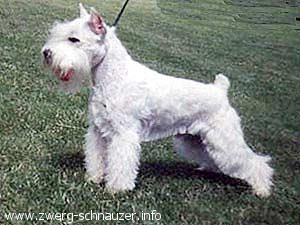
|
|
|
WW 00, EURO CH 00, INT CH , FIN CH , LUX CH , POL CH , SWE CH Wildwood US Crusade. Sweden (Pepalfa’s) A great asset for the breed who contributed to improve several lines in Europe.
|
|
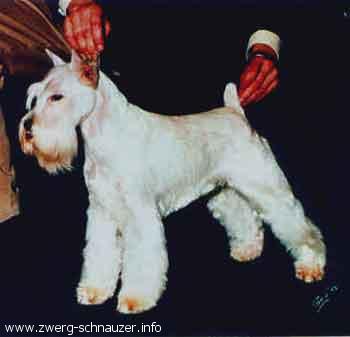
|
|
|
WW ‘01 , EURO CH , INT CH , BRA CH , ENG CH , FRA CH , LUX CH , PRT CH. Mr. King of Saint `Loui – Brazil. | Also an excellent stud who contributed to the improvement of Brazilian and European lines.
|
|
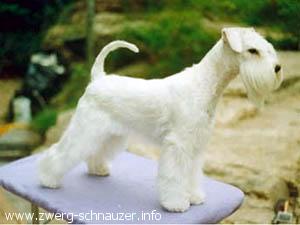
|
|
|
WW ‘02, INT CH , DNK CH Pepalfa’s Crystal Snow Quick – Sweden – Pepalfa’s | An excellent stud, ancestor to many of our dog |
|
|
RECENT HISTORY OF THE BREED AND ITS CURRENT DEVELOPMENT Among the better-known original breeders, we have to mention Margrit Roloff who created in Germany the von Bommerholz bloodline; her dogs can be tracked back in the pedigrees of almost all the European White Miniature Schnauzers. Among the breed fanciers who set the basis for the development of the breed both in Europe and the American continent, we have to mention van de Spikke Kennel in the Netherlands, Samantino Polonica in Poland, Wildwood in USA and Sant ‘Loui in Brazil. After that, by the end of the ‘80s and beginning of the ‘90s, other enthusiastic breeders started to work with the aim of improving the white minis, and some of them are currently producing very interesting lines, especially in Europe. The most outstanding (in my view) are Roxy’s Pride from the Netherlands (who have recently moved to Germany), Pepalfa’s Kennel in Sweden, Made in Spain from Spain, Mátraszépe from the Czech Republic, Bianco Olgas in Poland as well as some very good breeders in Russia. Also in USA it is worth mentioning some breeders who have contributed to opening up the lines of the White Mini, these are Alpat’s, Karwish and more recently Rice’s Kennel. In Brazil, Mr. King Kennel did a good job continuing the lines coming from the original Sant ‘Loui dogs. Currently, Ivana Abella and my friend Ana Clara Alves from Kennel Abella Barba are doing an excellent job with the white Minis in Brazil. In Argentina there is still not a kennel that concentrates exclusively in breeding the White Miniature Schnauzer. However, some Schnauzer breeders have taken in some White Minis, such is the case of von Portenschlag Kennel who introduced some of the dogs from Mr. King’s Kennel from Brazil, also Feeling’s Kennel has imported beautiful dogs from the Czech Republic and Hungary, and Alba’s Kennel is producing a few excellent Whites as well.
|
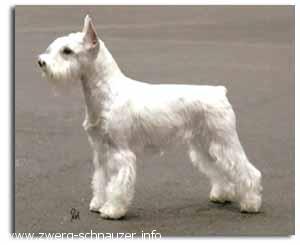
|
|
WW’02 , DNK CH , FIN CH , NOR CH , SWE CH Made in Spain Crisis - Sweden |
|
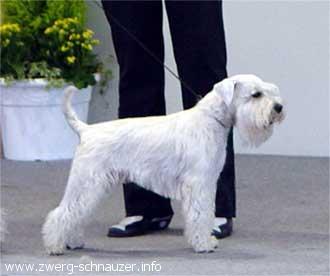
|
|
|
WW’03 , INT CH , GER CH. Erythro Trigenimus - Germany. |
|
|
THE WHITE MINIATURE SCHNAUZER AT SUDESTADA Probably
because it is the newest of the four Miniature Schnauzer breeds, the
quality of the White Mini is not as good as the other varieties,
therefore it still needs a lot of work in order to reach the quality,
structure and small size that can be appreciated in the other colours.
Our aim at SUDESTADA is to
concentrate exclusively on this variety of the Mini Schnauzer (aside
from our already known Irish Wolfhounds) and work intensely towards the
improvement of this beautiful breed, which is also an excellent
companion, easy to live with, of low maintenance, good health and
longevity.
|
|
|
JWW 2003 Fissura Trigenimus - Germany. |
|
|
|
|
|
WW’04 , EURO CH , EST CH , HUN CH, LTU CH Matraszepe Knight Rider. |
|
|
BREEDING THE WHITE MINIATURE SCHNAUZER TO OTHER COLOURS Some
countries have stricter rules than others regarding the breeding of the
White Mini to other colours of Miniature Schnauzer. For instance, in The
Netherlands it is absolutely forbidden, whilst in Argentina it is
allowed but with the breeder’s justification and the breed club’s
approval, and in Brazil it is totally legal. These differences in
regulation have a reason: the truth is that for improving the White
Miniature Schnauzer in relation to quality of the coat, structure
and size, it is necessary (when correctly justified and planned) to
cross the White Mini to excellent specimens of the other colours.
The
genetic explanation is as follows: If, for example, we breed a white
female to a Salt & Pepper male, the result would be Salt &
Pepper puppies with colour faults. But the puppies from this litter
would be ‘factored’; this means they are carriers of the white gene
that they have inherited from their dam. Therefore in a second breeding
of these puppies to a white specimen, we would obtain 50% of pure white
puppies and 50% of Salt & Pepper puppies (again with a colour flaw).
As it can be seen from this example, this practice is beneficial for
the White Mini (in only 2 generations we are already producing white
minis who have incorporated positive features carried by that first
excellent Salt & Pepper sire) However, this procedure is detrimental
to the Salt & Pepper breed because we would have produced one whole
litter and half of the second, of coloration faulted specimens. From
the viewpoint of the improvement of the White Mini, these procedures are
necessary in order to introduce beneficial changes in the breed, but it
is important to do it responsibly so as not to go against the
work done by the breeders of the other varieties of the White Mini. One
of the possible steps is to ensure that we 1) only breed the best
white specimens to excellent specimens of the other colours who
would introduce new features to the white minis that the breed doesn’t
currently carry. 2) Keep for a second generation breeding only the best
‘factored’ specimen from the first litter while giving the rest of
the litter away as pets, ensuring that they will not be bred from. The
same procedure should be done with the non-White specimens born from the
second litter. Only in this way would we contribute to the improvement
of the White Miniature Schnauzer without being too detrimental to the
other colours.
|
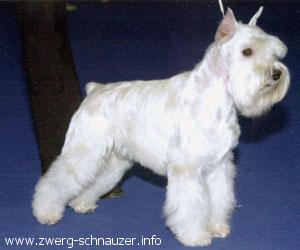
|
|
WW`05`06 , EURO CH `05 `06 , ARG CH , BLR CH , EST CH Star`s of White Night Versace – Russia. Uncle of our Bella. |
|
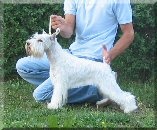
|
|
|
WW `06, EURO CH `06, POL CH |
|
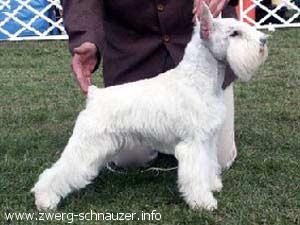
|
|
|
This
document was put together and writen by
Paula Colmegna of SUDESTADA Irish Wolfhounds & Miniature White
Schnauzers from Argentina www.criaderosudestada.com.ar
It can be reproduced as long as the source is cited. |
WW 07, J EURO CH 02, AM CH |
|
Bibliography: Sanchez,
J. 2005. El Nuevo Libro del Schnauzer Miniatura. Susaeta http://www.tierraverdekennel.com/historiaschnauzer.html http://www.illascies.com/standard.htm
http://www.schnauzerbranco.com.br/historico.shtml http://ricesminiatureschnauzers.com/page6.html http://www.freewebs.com/beanara/whiteminiatureinfo.htm http://www.goldenturok.com.br/shared/Artigos/CruzarCores.htm http://www.goldenturok.com.br/shared/schnauzer/WW/WW.htm http://www.dwergschnauzer.com/
|
|
Home |History | Standard | About us | Our Schnauzers |
Schnauzer Puppies | Schnauzer News | Links | Litters | Gallery
Copyright©
2007 - CRIADERO SUDESTADA Irish Wolfhound - All rights reserved
Dique Lujan | Buenos Aires | Argentina
Phone
from within Argentina: 03488-442009 | 011-15-6-702-6593
Phone from abroad: +54 3488-442009 | +54 911-6702-6593